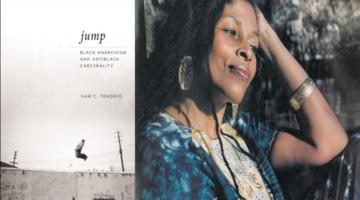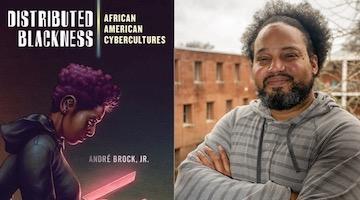Georgia’s convict leasing system was created to devour Black people of both genders.
White women defended the sterilization of Black women presumed to be inherently lascivious alongside the lynching of Black men presumed to be inherent rapists.”
(In this four-week symposium, we asked authors to comment on Sarah Haley’s book, No Mercy Here: Gender, Punishment, and the Making of Jim Crow Modernity. This week’s contributor is Jennifer S. Leath. Read the first part of the symposium, by Marisa Fuentes, here.)
“Mer-Seeps”
Jennifer S. Leath
No mercy trickling into the lives of the Black women whose archive is recovered through Sarah Haley’s No Mercy Here. Yet, the shadowy ghosts of Black women resurrected through Haley’s No Mercy Here is a mercy to those of us who have read Haley’s excavation of “the carceral life of race and gender ideology”[i] and heard the crashing, syncopated, lyrical, and embodied sounds of “sonic sabotage”[ii] disrupting the murderously white supremacist frequencies of modernity. The afterlife of the Black women swept into Georgia’s convict system – through convict leasing beginning in 1868, replaced in 1908 – is a mercy. No Mercy Here is haunting; that we can be haunted is a mercy.
Avery F. Gordon reminds us that “haunting and the appearance of specters or ghosts is one way . . . we are notified that what’s been concealed is very much alive and present, interfering precisely with those always incomplete forms of containment and repression ceaselessly directed toward us.”[iii] No Mercy Here puts the reader on notice that there is more to the history of the U.S. South than a basic reading of Michel Foucault’s “genealogy of punishment” can explain. Haley writes: “Although biopower was critical, in the South it was deployed to normalize white subjects, rather than to rehabilitate black ones inside. Public terror was not usurped by disciplinary power; instead discipline and public terror coincided in post-emancipation America.”[iv] Being haunted – discerning the haunting, understanding the haunting, feeling the haunting – is a mercy. Yet, it is more than a mercy.
“Discipline and public terror coincided in post-emancipation America.”
A gift, a curse: the haunting – and the curation of the haunting – is knowing “how to read the signs.”[v] Haley discerns the inseparability of discipline and public terror surface through a closer reading of women like Lizzie Patterson – notoriously “arrested and incarcerated several times” – as well Lizzie Patterson’s ghost. In her reading of Patterson and Patterson’s ghost, Haley not only identifies the ways that Patterson’s death became a “mechanism through which to invent a convenient narrative of black female transcendent attachment to captivity that reinforced the naturalness and tenability of their disproportionate imprisonment,”[vi] but also finds that “Patterson’s ghost represented the possibility of defiance with impunity, and some women imprisoned at Camp de Emmel mobilized her specter as a source of protection that ranged from threats to appeals to sympathy.”[vii] Reading the signs and between the lines, Haley feels the contraband of love in hell as she reads and writes the truth that “Black women in particular would need each other”[viii] when recalling the story of Adeline Henderson and Nancy Morris. Reading the signs and between the lines, Haley sees the significance of Mattie Crawford’s pants – and skirts – even when women like Frances Kellor cannot. Reading the signs and between the lines, Haley hears sabotaging “freedom dreams” and “black infrapolitics” embodied in “‘seemingly innocuous, individual acts of survival and resistance’”[ix]through the harshly punished “crimes floral in nature”[x] of Hattie Bishop, Carrie Williams, and Gladis Trumbick.
Seepages bear “witness to our own herstories” despite the fact that “we cannot hope to reconstitute ourselves in all our absences, or to rectify the ill-concealed presences that invade herstory from history”[xi]: these seepages are a mercy. Consider the physical seepages, the spiritual seepages, the judicial seepages, and the intimate seepages. The obscene odors, oddly colored vapors, rough textures, and whirring whips with barking dogs insist that our encounter with the herstory Haley presents is the mercy these ancestors offer to us and demand of us.
Intimate Seepages: Contradictions with respect to the logic applied to Black women’s intimacies are damning in No Mercy Here. Haley demonstrates the frequency with which Black women are subjected to convict leasing, chain gangs, and jail on account of charges of “infanticide” and murder of an (often abusive) male spouse and/or family member. However, she also provides proof of just how often courts refused to honor pleas for reunification with children, spouse, or family; moreover, she exposes the ubiquitous forms of sexual violence (including rape), erased and ignored offspring conceived and born within the penal to system to Black women that could only be the outcome of rape, and efforts of white women like Rebecca Latimer Felton to defend the sterilization of Black women presumed to be inherently lascivious alongside the lynching of Black men presumed to be inherent rapists. At times, the seepages are more like leaks. Haley excavates the life of “queer” that preceded its signifying male effeminacy or homosexuality: “‘queer’ was most consistently used in Atlanta’s mainstream press to describe perverse black bodies, ideas, and behaviors that could only be interpreted and governed through police and judicial action.”[xii] However, No Mercy Here at once exemplifies an affirmation of Audre Lorde’s warning that our silences will not protect us[xiii] and demonstrates the ways that silence did, at times, protect the women about whom she writes and was used as an important tool of resistance.[xiv] The timing of seepage as silence-breaking matters.
Judicial Seepages: Nowhere is it clearer how much the acculturation of our judiciary matters – and how plainly biased the United States judicial system has been historically – than through No Mercy Here. Haley not only spells out the ways that judges somehow, naturally, culturally knew that the 1908 chain gang law was meant to authorize the conscription of Black men and women (only) – and not white women,[xv] but she also demonstrates the ongoing challenge of systems of law and justice that can demonstrate bias through the extension and withholding of courtesies – without being illegal.[xvi] Beyond these more familiar flooding patterns of white supremacy, a seepage of No Mercy Here that may be a grace for those of us who have engaged the text is that there is firm evidence that convict labor changed from private to public hands.[xvii] While this did not spell the improvement of conditions for Black convicts, according to Haley’s research, this transition is critically important insofar as contemporary cultural analysis often reads the worsening of conditions for Black and Brown people in the United States as a matter of increasing privatization, and doubts the possibility of a return for social welfare management from private to public hands.
Spiritual Seepages: Merriam-Webster offers the following definitions of “mercy”: “compassion or forbearance . . . shown especially to an offender or to one subject to one's power”; “also: lenient or compassionate treatment”; “imprisonment rather than death imposed as penalty for first-degree murder”; “a blessing that is an act of divine favor or compassion”; “a fortunate circumstance”; “compassionate treatment of those in distress.”[xviii] These definitions not only reveal a flaw in the concept insofar as it is questionably applied to a penal system, but also a theological question that must be asked if these definitions of mercy coexist without contradiction. As Haley’s No Mercy Here clarifies, the specificity of “mercy” defined as a version “imprisonment rather than death” is dissonant at best. We need only to recall “Penitentiary Blues” from the Parchman Farm recordings: “Well the judge that sentenced me ought to be here his self, his self / ‘Cause I’d rather be dead, Lord, than to be in this lowdown place.”[xix] Theologically: what kind of deity permits an earthly fate worse than death; what kind of deity withholds favor or compassion from the innocent; what kind of deity – even temporarily – honors the convictions of a white supremacist society and its judiciary? With such disturbed concept of mercy: is mercy worth seeking (or seeping)? We dare not wonder at the recovery of the demonic as disruption of entropy: despite “the devil round the head of my bed,” Haley explores the sonic, imaginative, and carceral fugitivity of “Rosie” (a character invoked in at least two chain gang song lyrics) quoting the lyricist of “Go Way Devil” who continues, “Wake up, Rosie, tell your midnight dream.”[xx]
Physical Seepages: At the height of her description of a merciless carceral system, sounds of resistance and insistences on survival, liberation, and justice interrupt. With Sylvia Winter and Katherine McKittrick, Haley suggests that the specific interruption of the demonic is an affront to the second law of thermodynamics: a law that can be variously stated, but ultimately confesses the inevitability of entropy. Haley explains: “The demonic confronts thermodynamic inevitability and irreversibility, undermining temporal, spatial, and indeed historical inexorability by manipulating the order of things from the periphery.”[xxi] However, the demonic – which, depending on one’s reading of it may act to instigate order or to instigate disorder, directly or indirectly – must have as much to do with the first law of thermodynamics as it does with the second. The first law of thermodynamics suggests that the total energy, the total heat of a system is constant. While the form of energy (and matter) can be transformed, energy (and matter) can neither be created nor destroyed. The introduction of energy or matter (i.e., another way to read the demonic) that is not as though it is, were, or will be, or that is though it has not altogether been thought – is an interruption of the first law of thermodynamics. In this way, there is a seepage between the physical, multidimensional attributes at stake in navigating the geographies of carceralities, fugitivities, and liberations. Several questions arise from these meta-physical contemplations: Is the demonic (always) synonymous/coterminous with evil? What is at stake if and when we fail to identify the demonic, misidentify the demonic, and/or fail to confront the demonic with our liberating “midnight dreams”?
Mercy, like grace, is a queer possibility for the soul. As he wrestles with contemporary circumstances of mass incarceration, Bryan Stevenson posits that “mercy is just when it is rooted in hopefulness and freely given. Mercy is most empowering, liberating, and transformative when it is directed at the underserving. The people who haven’t earned it, who haven’t even sought it, are the most meaningful recipients of our compassion.”[xxii] Where are the drops of mercy in this framework for hopeless ones with nothing more to give? Where does mercy trickle down to the deserving and most deserving? Shouldn’t there be heaps of mercy seeping and permeating (i.e., mer-seeps) for those who have earned and sought it, women and men who live out the carceral inheritances of the convict leasing and chain gangs of Atlanta – not through an agreement to play by the rules of white supremacy and accept the criminality and servitude of Black people, but through a refusal to submit to such a culture? What seeps out from No Mercy Here cannot, must not, does not lie. Like most seepages -- beyond the mind of its sources – it touches who and what and how and where and when it touches.
Jennifer S. Leath is Assistant Professor of Religion and Social Justice at Iliff School of Theology.
COMMENTS?
Please join the conversation on Black Agenda Report's Facebook page at http://facebook.com/blackagendareport
Or, you can comment by emailing us at comments@blackagendareport.com
[i] Haley, No Mercy Here, 5.
[ii] Haley, 216.
[iii] Gordon, Ghostly Matters: Haunting and the Sociological Imagination, Introduction.
[iv] Haley, No Mercy Here, 27.
[v] Gordon, Ghostly Matters: Haunting and the Sociological Imagination, 164.
[vi] Haley, No Mercy Here, 41.
[vii] Haley, 41–42.
[viii] Haley, 63.
[ix] Kelley, Race Rebels, 9 in Haley, No Mercy Here, 202.
[x] Haley, No Mercy Here, 195.
[xi] Carby, Cultures in Babylon, 67 in Haley, No Mercy Here, 249.
[xii] Haley, No Mercy Here, 40.
[xiii] Lorde, Sister Outsider.
[xiv] Haley, No Mercy Here, 210.
[xv] Haley, 158.
[xvi] Haley, 175.
[xvii] Haley, 155.
[xviii] “Definition of MERCY.”
[xix] Haley, No Mercy Here, 226.
[xx] Haley, 228.
[xxi] Haley, 230.
[xxii] Stevenson, Just Mercy, 314.



















